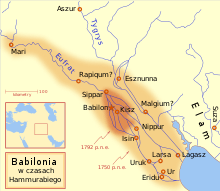Rapiqum
Rapiqum was a city of Ancient Mesopotamia during the second millennium BC. The city was located in the north of Babylon, probably on the eastern bank of the Euphrates River, somewhere in the vicinity of today's Ramadi in Iraq; the exact location remains unknown.[1]
History
The city is mentioned in several transaction records of the time,[2] the records of king Sin-Iddinam of Larsa,[3] and of the Mari kingdom.[4]
The city had been independent but was taken by Hammurapi in his 10th or 11th year of rule (around 1782 BC).[5][6][7] It thereafter remained in Babylonia. It was also taken at various times by Adad-nirari I, of Assyria[8] and Ibal-pi-el II of Eshnunna.[9]
Location

The exact location of the city remains unknown but it appears to have been a border town of the Babylonian kingdom,[10] on the Euphrates River, situated between Suhûm and Babylonia,[11] somewhere near the Mari kingdom in Old Babylonia, and north of Babylon.
Its exact location was previously thought to be near Ramadi but recent excavations suggest Tell Anbar, near Fallujah.[11] Excavations in the area of Fallujah have revealed textual evidence of the city of Rapiqum.
References
- Marek Stepien, The Code of Hammurabi, ALFA Publishing, Warsaw 2000, p. 158, ISBN 83-7179-192-5.
- P. Meer, ABOUT THE SHIPMENT OF DADUŠA IN QABRA Review of Assyriology and Eastern Archeology 47, No. 1 (1953), p. 16-22.
- W. F. Leemans, Foreign trade in the old Babylonian period as revealed by texts from Southern Mesopotamia (Brill Archive, 1960), p. 140.
- Wolfgang Heimpel, Letters to the King of Mari: A New Translation, with Historical Introduction, Notes, and Commentary (Eisenbrauns, 2003) p. 393.
- W. F. Leemans, Foreign trade in the old Babylonian period as revealed by texts from Southern Mesopotamia (Brill Archive, 1960), p. 180.
- William J. Hamblin, Warfare in the Ancient Near East to 1600 BC: Holy Warriors at the Dawn of History (Routledge, 27 Sep. 2006), pg. xx.
- E. Sollberger, The Cambridge Ancient History, Volumes 1-2 (Cambridge University Press, 1970), p. 177.
- The Upper Mesopotamian empire.
- E. Sollberger, The Cambridge Ancient History, Volumes 1-2 (Cambridge University Press, 1970) p. 7.
- Wolfgang Heimpel, Letters to the King of Mari: A New Translation, with Historical Introduction, Notes, and Commentary (Eisenbrauns, 2003), p.9, p. 45, p. 51-52.
- Denis Lecambre, Sippar and the Frontier between Ešnunna and Babylon. New Sources for the History of Ešnunna in the Old Babylonian Period p. 158.